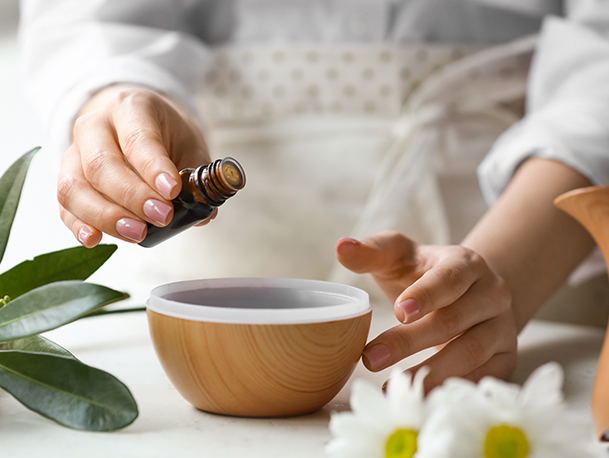- Benefits of Diffusing Blends
- Tips for Blending Essential Oils
- Creating Your Own Essential Oil Diffuser Blends
- Contraindications for Essential Oils
One of the best ways to enhance your aromatherapy experience is to diffuse essential oils throughout the home. The essential oil diffuser offers an easy and convenient way to add rich fragrance to any room while also exhibiting healing properties. There is a plethora of unique synergy blends on the market that feature specific aromas or serve certain purposes. However, if you have a collection of individual essential oils, you may be curious to try your hand at creating your own essential oil diffuser blends.
Blending essential oils from scratch can be challenging. Since it is considered part art and part science, it may be difficult to know which oils compliment one another, what kind of effect the blend will have, or how much of each oil to use. However, with a little bit of knowledge, you can create beautiful essential oil diffuser blends that suit your needs and reflect your favorite aromas. Continue reading for guidance on making your own essential oil combinations based on scent type, desired effect, and essential oil notes.
BENEFITS OF BLENDING AND DIFFUSING ESSENTIAL OILS
Diffusing essential oils throughout your space is one of the most common ways to enjoy the healing benefits of aromatherapy. Choosing your favorite oils based on scent is an effective way to customize your experience to suite your aromatic preferences, making your space unique to you. Diffusing essential oil blends to achieve a specific result can also be beneficial for supporting your overall health. Due to their dynamic chemical compounds, essential oil combinations work synergistically when blended to enhance the healing properties of each oil. Whether you are looking to relax prior to bedtime, ground yourself during your meditation practice, or are trying to increase focus during your workday, essential oils work better when complementary oils are blended together.
TIPS FOR BLENDING ESSENTIAL OILS
There are a few different approaches you can take to creating essential oil diffuser blends. Taking a moment to categorize your oils of choice can help you to get organized and to control the result of your unique essential oil combinations. You can blend and diffuse essential oils based on effect (calming, relaxing, energizing, etc.), by scent (woody, spicy, citrus, floral), or by their notes (the chemical make-up of how fast each oil evaporates).

BLENDING BY EFFECT
Due to their chemical compounds, each essential oil exhibits a specific effect on the mind, body, and spirit. Some oils awaken the senses and supply a natural energy boost, while other oils are associated with gentle, calming energy. You can choose more than one oil from any of these categories, and some oils may overlap in effect, such as an energizing oil that is simultaneously relaxing.

Essential Oils Based on Effect
Energizing essential oils include Rosemary, Clary Sage, Bergamot, Lemongrass, Eucalyptus, Peppermint, Tea Tree, Cypress, Pine, Lemon, Basil, Grapefruit, and Ginger.
Calming essential oils include Lavender, Geranium, Mandarin, Bergamot, Ylang Ylang, Neroli, Palmarosa, Patchouli, Petitgrain, and Sandalwood.
Detoxifying essential oils include Peppermint, Juniper, Grapefruit, Rosemary, laurel Leaf, Mandarin, Lemon, Patchouli, Hyssop, and Helichrysum.
Grounding essential oils include Lavender, Geranium, Chamomile Roman, Marjoram, Sandalwood, Bergamot, Pepper Black, Tangerine, Sweet Orange, and Melissa Leaf.
BLENDING BY SCENT PROFILE
Let your senses be your guide! Choosing your essential oil blend based on your favorite scents is the most intuitive way of creating essential oil diffuser blends that you will enjoy. You can pick more than one oil from the same category, or pair oils in contrasting scent profiles to create a harmonious and unique blend. Certain aromas can also evoke emotions that are linked to certain memories or atmospheres.
Scent Categories and Their Associated Emotions
Floral oils are believed to exhibit a relaxing, nurturing, and uplifting atmosphere that can set the tone for winding down at the end of the day. Floral oils are also associated with sensuality and romance and are used in numerous aphrodisiac blends, and their soft aromas infuse seamlessly with any other scent profile. Examples of floral oils include Geranium, Jasmine, Lavender, Palmarosa, Rose, and Ylang Ylang.
Citrus oils produce a reviving yet calming atmosphere. Their bright and uplifting aromas are often associated with summery or tropical blends but can also add warmth to a holiday blend. The sweet nature of citrus oils integrates nicely with floral, minty, spicy, and woody oils. Some of the most commonly used citrus oils include Bergamot, Citronella, Grapefruit, Lemon, Lemongrass, Lime, Melissa, Neroli, Sweet Orange, Petitgrain, and Tangerine oils.
Spice oils are invigorating and warming, providing a comfort that can evoke a feeling of nostalgia. Certain spice oils can also awaken the senses and exhibit a motivational quality. Spice oils infuse best with floral and citrus scents and should be used marginally in a blend since they can easily overpower the other aromas. Some of the most popular spice oils include Cinnamon, Clove, Ginger, Nutmeg, and Pepper Black oils.
Woody oils are believed to possess a centering and grounding quality. They are stabilizing and calming while also inspiring strength and empowerment. Woody oils include Cedarwood, Coriander, Cypress, Fir Needle, Frankincense, Helichrysum, Juniperberry, Myrrh, Patchouli, Sandalwood, and Vetiver.
Herbaceous are believed to be clarifying and balancing and can add a spring clean feel to your space. They are also believed to be balancing oils, which help to stabilize mental and emotional health. Some well-known herbaceous oils include Basil, Chamomile, Clary Sage, Eucalyptus, Marjoram, Oregano, Peppermint, Pine, Rosemary, Sage, Tea Tree, and Thyme.
BLENDING BY ESSENTIAL OIL NOTE
Lastly, blending essential oil diffuser blends based on their corresponding note requires a little more scientific understanding. Every essential oil falls into one of three categories: top note, middle note, and base note. These categories determine how quickly a particular oil evaporates into the air, as well as the scent you notice first when you take a whiff of an essential oil blend. Top notes are the most striking scents and are the first to penetrate the scent activators in the nose. Top notes are also the quickest to evaporate, only lasting between 1 to 2 hours. Middle notes are the heart of the blend, usually requiring the greatest number of drops. Evaporating within 2-4 hours, middle notes are typically soft, providing balance in an essential oil diffuser blend. Creating a solid foundation for the top and middle notes are the base notes. Rich, dense, and smooth, with a lingering depth in scent, base notes take the longest to evaporate, to the extent that some base note oils can last up to several days. Essential oil combinations that follow this structure typically smell differently when they are first blended compared to when they have been diffused after a few hours.
When blending essential oils this way, it is important to balance the three notes. The oils may not be perfectly equal, but they will still work synergistically to enhance their best aromatic qualities. It is also important to ensure that the ratio does not allow one aroma to overpower the other.
Examples of Essential Oil Notes
Top notes possess a short but striking fragrance, making it the first scent that people notice in a blend. Oils that are top notes include Bergamot (also a middle note), Lemon, Lime, Palmarosa, Basil (also a middle note), Citronella, Peppermint, Coriander, and Fennel Sweet.
Middle notes are softer and last longer than top notes while being less distinct than base notes. These oils work to bring out the top and base notes in a blend. Middle notes include Eucalyptus, Juniper berry, Rosemary, Geranium, Helichrysum, Lavender, Neroli, Chamomile Roman, Ylang Ylang (also a base note), Clary Sage, Oregano, Thyme, Ginger (also a base note), Pepper Black, Cardamom, and Nutmeg.
Base Notes are stronger and sharper, creating a long-lasting foundation for layering the top and middle notes of the blend. Essential oils that are base notes are typically intense, rich, relaxing, and grounding. They include Jasmine, Spikenard, Vetiver, Patchouli, Frankincense, Cedarwood, Sandalwood, and Myrrh oils.
CREATING YOUR OWN ESSENTIAL OIL DIFFUSER BLENDS
If you are new to blending essential oils, begin by choosing the oils that align with your scent preferences. Opting for oils that you are already familiar with makes it easier to get comfortable with blending oils and eventually experimenting with different aromas. You can also choose 2 to 5 oils that generate a specific effect, such as choosing oils that are relaxing or energizing. Be sure to choose oils that share similar traits to achieve the best results.
Prior to applying drops of your chosen essential oils into your diffuser, you can conduct a test to see how your essential oil combination interact with one another. You can do this by smelling the bottles together with the caps off or, for a more accurate scent, apply a few drops of each oil onto a cotton swab and hold the swabs together when taking a whiff.
If you choose to create your essential oil diffuser blend based on the note categories, ensure you have one top note, one middle note, and one base note oil. For a balanced aromatic blend, start by creating a 20% dilution to ensure the diffuser blend is not overpowering. Creating a small batch in sample bottles is recommended to start. Apply 1drop of the base note, 3 drops of the middle note, and 1 drop of the top note. Follow with 20 drops of your carrier oil of choice, achieving a ratio of 1-part essential oils to 4 parts carrier oil. Label your new diffuser blend to keep track of the essential oils you used and pay attention to how the blend changes as you diffuse it throughout your space.
CONTRAINDICATIONS FOR ESSENTIAL OILS
All New Directions Aromatics Essential Oils are for external use only. They should not be ingested and should not be stored within the reach of children, in case of accidental ingestion. As with essential and carrier oils, a patch test should be conducted on the inner arm or another generally insensitive area of skin, using a dime-size amount of the specified oil to check for sensitivities. An absence of an allergic response within 48 hours suggests that the oil is safe to use.
The topical application of most carrier oils is generally known to be safe with responsible use, but irritations, allergies, rashes, and other side effects are possible. In the chance of an allergic reaction, discontinue use of the product and see a doctor, pharmacist, or allergist immediately for a health assessment and appropriate remedial action. To prevent side effects, consult with a medical professional prior to use.
Essential or carrier oils must never be used near the eyes, inner nose, and ears, or on any other particularly sensitive areas of skin.
